Lloyds Banking Group Bundle
Who Really Controls Lloyds Banking Group?
Understanding the ownership of Lloyds Banking Group is crucial for anyone navigating the complexities of the financial world. From its roots in 1765 to its current status as a UK financial powerhouse, Lloyds' journey has been marked by significant shifts in ownership. The 2008 financial crisis, in particular, reshaped the company's landscape, making it essential to understand the current Lloyds Banking Group SWOT Analysis and who holds the reins today.
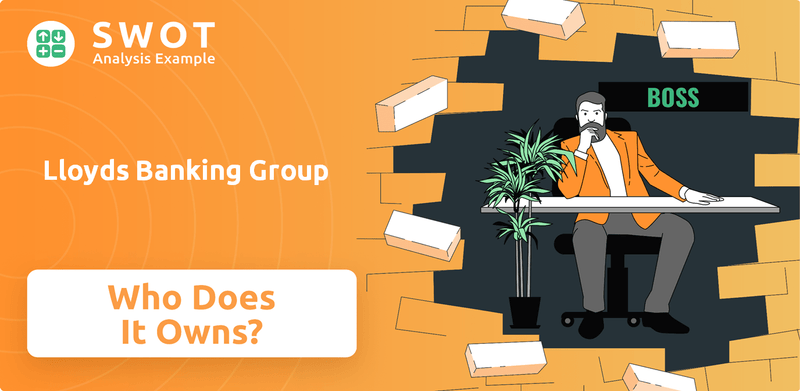
This exploration into Lloyds ownership will uncover the key players shaping its future. We'll examine the Lloyds Group structure, from the influence of major Lloyds shareholders to the impact of public ownership, providing a comprehensive view of who controls Lloyds Bank. Delving into the history of Lloyds Bank and its financial performance, this analysis offers valuable insights for investors and business strategists alike, answering critical questions about Lloyds Banking Group stock ownership and the company's strategic direction.
Who Founded Lloyds Banking Group?
The genesis of the current Lloyds Banking Group can be traced back to 1765 with the establishment of Taylors and Lloyds in Birmingham. This foundational entity was the brainchild of John Taylor, a button maker, and Sampson Lloyd II, an iron producer. Their initial investment of £2,000 each marked the beginning of what would become a major financial institution.
Sampson Lloyd, a Quaker, and John Taylor, a Unitarian, brought diverse backgrounds to the partnership. This blend of skills and perspectives, coupled with their initial capital, set the stage for the bank's early success. For nearly a century, the bank operated from a single office, supporting the burgeoning trade and industry of the Industrial Revolution.
The transition to a joint-stock company in 1865, when it was renamed Lloyds Banking Company Ltd., was a pivotal moment. This shift allowed for a broader ownership base, incorporating shareholders and a formal board of directors. This change facilitated significant capital increases and paved the way for future expansion and growth.
John Taylor and Sampson Lloyd II were the key founders of Lloyds Bank. They each invested £2,000 to start the bank. Their combined expertise in manufacturing and iron production was crucial.
For its first century, the bank operated from a single office in Birmingham. This office served as the central hub for financing regional trade and industry. The bank played a vital role during the Industrial Revolution.
In 1865, Lloyds became a joint-stock bank, named Lloyds Banking Company Ltd. This transition allowed for a broader ownership base. This was a significant shift in the bank's structure.
Early ownership was concentrated among the founding partners. The move to a joint-stock structure in 1865 distributed ownership. The bank's capital increased substantially.
The shift to a joint-stock company facilitated the bank's expansion. Over the next five decades, Lloyds absorbed over 50 other banks. This growth solidified its position in the UK banking sector.
The bank's early years were marked by its role in financing during the Industrial Revolution. The transformation to a joint-stock company was essential. This change enabled the bank's future growth.
The early ownership of Lloyds Banking Group started with a private partnership between John Taylor and Sampson Lloyd II. The shift to a joint-stock company in 1865 broadened the ownership base, allowing for more shareholders. The initial investment by each founder was £2,000, setting the financial foundation for the bank.
- The original founders, John Taylor and Sampson Lloyd II, each invested £2,000.
- The bank's structure evolved from a private partnership to a joint-stock company.
- The change in ownership was crucial for the bank's expansion.
- The bank's growth was supported by its early role in financing during the Industrial Revolution.
Lloyds Banking Group SWOT Analysis
- Complete SWOT Breakdown
- Fully Customizable
- Editable in Excel & Word
- Professional Formatting
- Investor-Ready Format
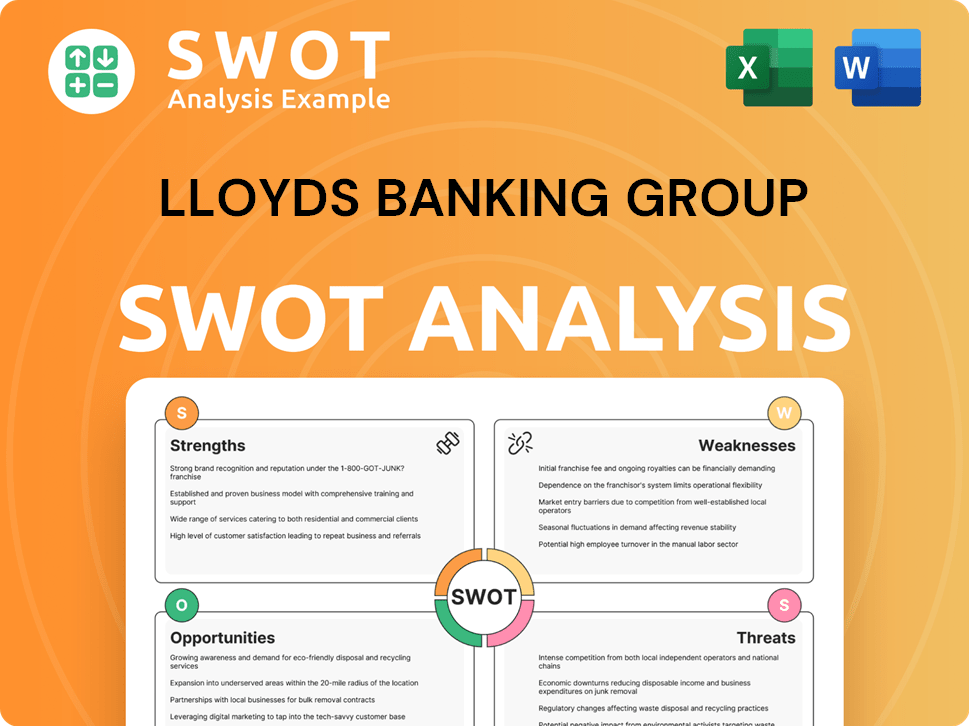
How Has Lloyds Banking Group’s Ownership Changed Over Time?
The ownership of Lloyds Banking Group has seen significant changes, particularly due to mergers and the 2008 financial crisis. In 1995, Lloyds Bank plc merged with TSB Group plc, forming Lloyds TSB Group plc. This was structured as a reverse takeover, with former Lloyds Bank shareholders holding a 70% equity interest. A key acquisition was Scottish Widows in 2000 for £7 billion, positioning the group as the second-largest UK provider of life assurance and pensions at the time. These moves shaped the early ownership structure of what would become a major player in the financial sector.
The 2008 financial crisis brought the most dramatic shift. The UK government intervened, initially taking a 43.4% stake in Lloyds Banking Group after its acquisition of HBOS in January 2009. This stake was later increased to 65% in March 2009. The government gradually sold its shares, resuming sales in November 2016 and reducing its holding to 7.99%. By March 17, 2017, the British government had sold its remaining shares, returning the company to full private ownership. This marked a complete transition from government control back to private shareholders, reshaping the Lloyds ownership landscape.
| Event | Date | Impact on Ownership |
|---|---|---|
| Lloyds Bank plc and TSB Group plc Merger | 1995 | Formation of Lloyds TSB Group plc; former Lloyds Bank shareholders held 70% equity. |
| Acquisition of Scottish Widows | 2000 | Expanded the group's presence in life assurance and pensions. |
| UK Government Intervention | 2008-2009 | Government acquired a stake, peaking at 65%, due to the financial crisis. |
| Government Share Sales | 2016-2017 | Gradual return to private ownership; government sold its remaining shares by March 2017. |
Currently, Lloyds Banking Group is publicly traded on the London Stock Exchange (LSE: LLOY) and the New York Stock Exchange (NYSE: LYG). As of May 2025, institutional investors hold a significant portion of the company's ADRs. Major institutional shareholders as of March 30, 2025, include Fisher Asset Management, LLC with 0.88% (132,122,777 shares), Mondrian Investment Partners Ltd with 0.44% (66,050,307 shares), and Arrowstreet Capital Limited Partnership with 0.22% (33,369,382 shares). Mutual Funds have decreased their holdings from 0.61% to 0.60% as of May 2025. The company's total assets increased to £906.697 billion in 2024. Understanding the Lloyds shareholders and the Lloyds Group structure is key to assessing its financial health. Learn more about the company's financial operations in our article on Revenue Streams & Business Model of Lloyds Banking Group.
The ownership of Lloyds Banking Group has evolved significantly, influenced by mergers and government intervention.
- The UK government's stake, acquired during the 2008 financial crisis, was fully divested by March 2017.
- Institutional investors hold a substantial portion of the company's shares as of May 2025.
- Major shareholders include Fisher Asset Management, Mondrian Investment Partners Ltd, and Arrowstreet Capital Limited Partnership.
- The company's total assets increased to £906.697 billion in 2024.
Lloyds Banking Group PESTLE Analysis
- Covers All 6 PESTLE Categories
- No Research Needed – Save Hours of Work
- Built by Experts, Trusted by Consultants
- Instant Download, Ready to Use
- 100% Editable, Fully Customizable
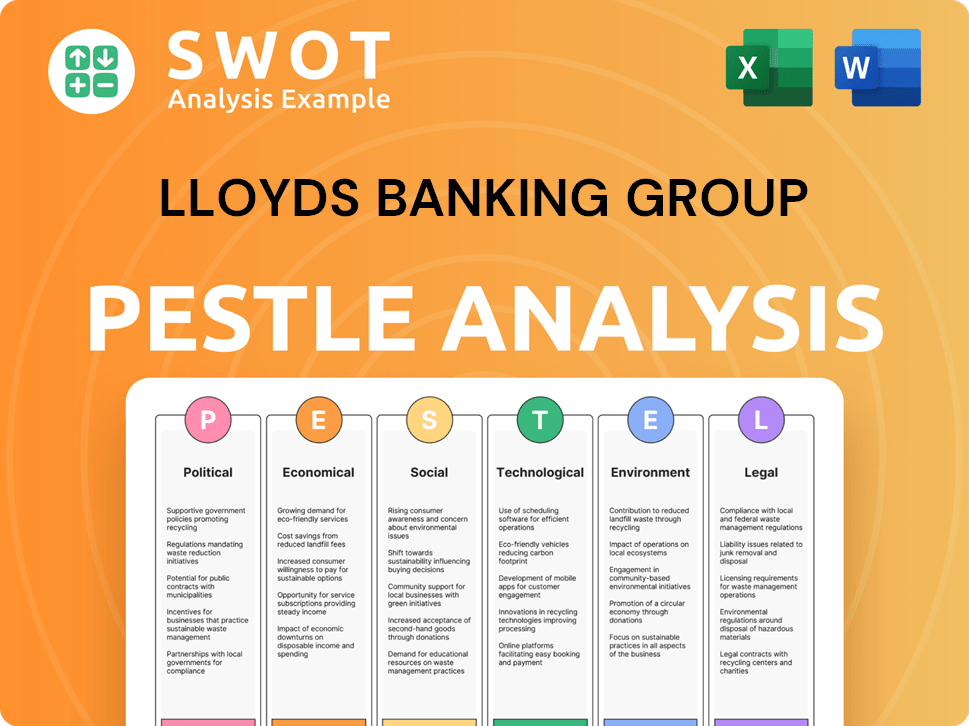
Who Sits on Lloyds Banking Group’s Board?
The Board of Directors at Lloyds Banking Group is responsible for overseeing the company's strategic direction and governance, acting on behalf of its shareholders. The board includes executive, non-executive, and independent directors. While an up-to-the-minute, comprehensive list of all board members and their specific shareholdings for 2025 isn't available in a single public source, the company details these aspects in its annual reports and proxy statements. The 2024 Annual Report and Accounts, released on February 20, 2025, provides information on the company's strategy and performance, including financial and operational results.
Recent updates include the appointment of Nathan Bostock to the Board and as Chair of Lloyds Bank Capital Markets plc, effective August 1, 2024. He is standing for election in 2025. The Annual General Meeting in May 2025 included resolutions for directors' re-election and the approval of the final dividend for 2024. The company's latest annual report and SEC filings provide further details on the board and governance. Understanding the target market of Lloyds Banking Group is crucial for investors.
| Director | Role | Notes |
|---|---|---|
| Charlie Nunn | Group Chief Executive | |
| William Chalmers | Chief Financial Officer | |
| Robin Budenberg | Chairman |
The voting structure of Lloyds Banking Group is based on ordinary shares of 10p each. As of April 30, 2025, the total number of shares issued by Lloyds Banking Group plc with voting rights exercisable in all circumstances at general meetings is 60,142,756,773 ordinary shares. Each ordinary share has equal voting power, adhering to a one-share-one-vote principle. There are no indications of dual-class shares or special voting rights that would give disproportionate control to specific entities. This structure helps define the Lloyds ownership and the influence of Lloyds shareholders.
The Board of Directors oversees Lloyds Banking Group, representing shareholders' interests. The company operates on a one-share-one-vote principle, ensuring equal voting power for each ordinary share.
- Board composition includes executive, non-executive, and independent directors.
- Annual reports and SEC filings provide detailed information on board members and governance.
- Recent appointments and re-elections reflect ongoing governance practices.
- No significant proxy battles or activist investor campaigns have been reported.
Lloyds Banking Group Business Model Canvas
- Complete 9-Block Business Model Canvas
- Effortlessly Communicate Your Business Strategy
- Investor-Ready BMC Format
- 100% Editable and Customizable
- Clear and Structured Layout
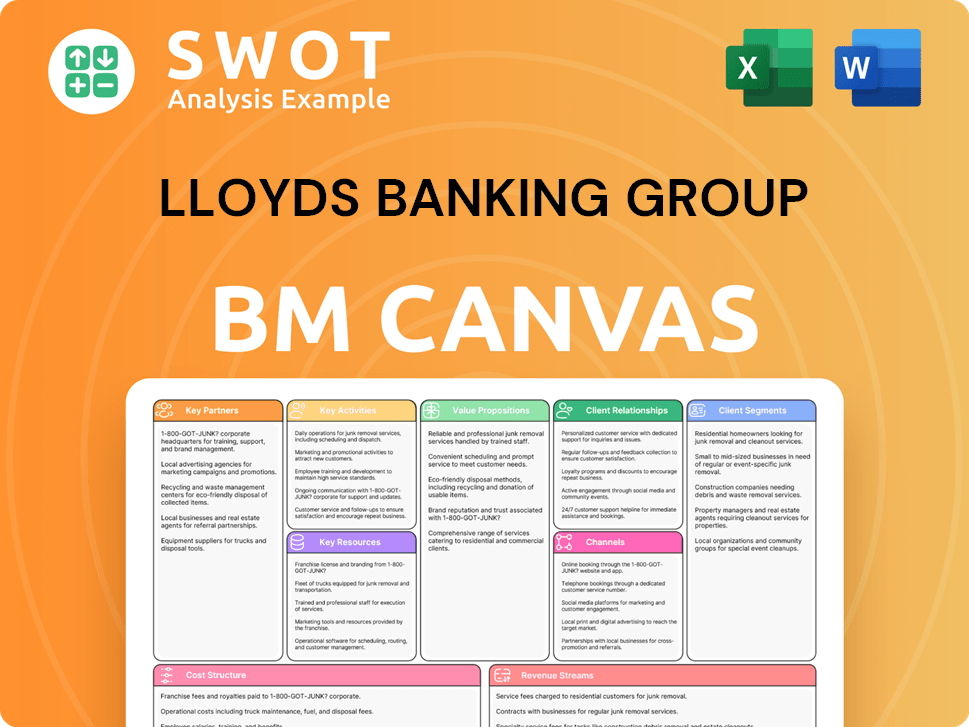
What Recent Changes Have Shaped Lloyds Banking Group’s Ownership Landscape?
Over the last few years, the ownership profile of Lloyds Banking Group has been shaped by significant share buyback programs, which have returned substantial capital to Lloyds shareholders. In February 2025, a new $900 million share buyback program was announced, following an $800 million program in 2024. As of May 7, 2025, $324 million (£251 million) of the new program had already been spent. These initiatives have reduced the total number of voting rights, reflecting a strategic focus on capital efficiency and shareholder value. These buybacks follow previous programs of $750 million in 2023 and $500 million in 2022, which collectively reduced voting rights by 4.6%, 6.1%, and 5.0% respectively.
In addition to share buybacks, Lloyds Bank has been strategically expanding its operations. An example of this is the incorporation of Citra Pathways in April 2024 by Lloyds Banking Group's subsidiary, Lloyds Living (formerly Citra Living). This move into for-profit housing, particularly shared ownership, suggests a diversification of the group's investment portfolio. The evolving Lloyds Group structure reflects a dynamic approach to market opportunities and strategic growth.
| Metric | Details | Latest Data |
|---|---|---|
| Share Buyback Program (2025) | Amount | $900 million |
| Share Buyback Program (2025) | Amount Spent (as of May 7, 2025) | $324 million (£251 million) |
| 2024 Final Dividend | Per Share | 2.11 pence |
| Projected Dividend Yield (2025) | 5.6% | |
| Projected Dividend Yield (2026) | 6.5% |
The company's commitment to shareholder returns is further evidenced by the final dividend of 2.11 pence per share for 2024, approved for payment in May 2025. The projected dividend yield for 2025 is 5.6% and 6.5% for 2026. The company continues to monitor economic and regulatory developments, with a focus on strategic initiatives to drive sustainable growth. For 2025, Lloyds Banking Group aims for underlying net interest income of around £13.5 billion and a return on tangible equity (ROTE) of about 1.35%, with a target of over 15% for 2026. For more insights into the competitive landscape, consider reading about the Competitors Landscape of Lloyds Banking Group.
Lloyds Banking Group has been actively returning capital to shareholders through share buyback programs. These programs have significantly reduced the total number of voting rights.
The incorporation of Citra Pathways indicates strategic diversification. The company is also focused on driving sustainable growth through various initiatives.
Lloyds Bank continues to reward its shareholders with dividends. The final dividend for 2024 was approved for payment in May 2025.
Lloyds Banking Group aims for an underlying net interest income of around £13.5 billion for 2025. They have a ROTE target of over 15% for 2026.
Lloyds Banking Group Porter's Five Forces Analysis
- Covers All 5 Competitive Forces in Detail
- Structured for Consultants, Students, and Founders
- 100% Editable in Microsoft Word & Excel
- Instant Digital Download – Use Immediately
- Compatible with Mac & PC – Fully Unlocked
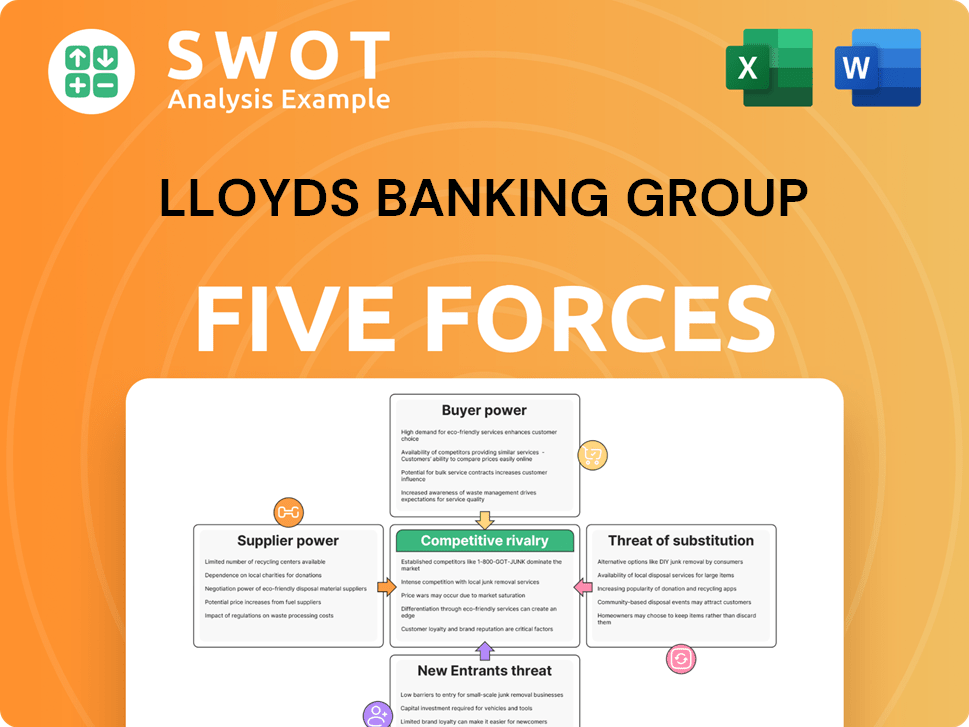
Related Blogs
- What are Mission Vision & Core Values of Lloyds Banking Group Company?
- What is Competitive Landscape of Lloyds Banking Group Company?
- What is Growth Strategy and Future Prospects of Lloyds Banking Group Company?
- How Does Lloyds Banking Group Company Work?
- What is Sales and Marketing Strategy of Lloyds Banking Group Company?
- What is Brief History of Lloyds Banking Group Company?
- What is Customer Demographics and Target Market of Lloyds Banking Group Company?
Disclaimer
All information, articles, and product details provided on this website are for general informational and educational purposes only. We do not claim any ownership over, nor do we intend to infringe upon, any trademarks, copyrights, logos, brand names, or other intellectual property mentioned or depicted on this site. Such intellectual property remains the property of its respective owners, and any references here are made solely for identification or informational purposes, without implying any affiliation, endorsement, or partnership.
We make no representations or warranties, express or implied, regarding the accuracy, completeness, or suitability of any content or products presented. Nothing on this website should be construed as legal, tax, investment, financial, medical, or other professional advice. In addition, no part of this site—including articles or product references—constitutes a solicitation, recommendation, endorsement, advertisement, or offer to buy or sell any securities, franchises, or other financial instruments, particularly in jurisdictions where such activity would be unlawful.
All content is of a general nature and may not address the specific circumstances of any individual or entity. It is not a substitute for professional advice or services. Any actions you take based on the information provided here are strictly at your own risk. You accept full responsibility for any decisions or outcomes arising from your use of this website and agree to release us from any liability in connection with your use of, or reliance upon, the content or products found herein.